On few occasions do our travels demand degrees of endurance – there's some concern about today's destination: the Campanile di Giotto (1298-1359), 84.7 metres (277.9 ft) tall, 414 steps to the roof level. Anxiety is the companion of big numbers. Also, it's our last day in Firenze (Florence, pop 367,150 in 2022) and we want to see as much as possible.
We remember last summer's big climb as 'manageable': the Belfort van Brugge (13th century), 83 m (272 feet) high, 366 steps to the level of the bells. We dig more than a decade into the past for a 'real struggle', also here in Firenze: the Cupola del Brunelleschi (1420-36), external height of 116.5 m (382 ft, to the cross), 463 steps to the lantern.
As with many tourist sites there days, our tickets are timed. Ours are for 10:20AM. So after an early, breakfast, we make our way to the Cattedrale di Santa Maria del Fiore (13th-15th centuries) and join the queue on the east side of the Campanile. Our time in line affords an opportunity to study the buildings.
The bell tower is named for Giotto, the Proto-Renaissance painter and Arnolfo di Cambio's successor as capomastro (1302; saw his last frescos in the Bargello yesterday). The Giotto's design works in a series of layered pairs that create a stack of registers, like those at the Cappella degli Scrovegni. Upon a stout base, the first register is a series of seven esagoni (hexagons) and a series of lossinge (lozenges, diamonds), panel forms separated by dark mouldings; the next register a set of four nicchie ogivali (ogival sculptural niches) and a set of 'flat' nicchie separated by lighter, wider stripes; then a register of paired double-lancet openings enclosed by floral bands; and finally, for the top of the tower and the bells, a taller triple-lancet grill.
The corona is a finished with a piattaforma aggettante – a corbeled parapet. The corners are bolstered by polygonal buttresses which telescope upward, thus completing the visual frame for each side.
The effect is a succession of ever higher, lighter, and more open levels as the tower rises. The sculptural works in the esagoni, lossinge, and nicchie are generally attributed to Andrea Pisano, who follows Giotto as capomastro (1343). The upper 'window' levels are ascribed to Francesco Talenti, who follows Pisano (1351).
From this distance and in this light, it is difficult to make out any of the sculptures except the single niche with two figures right above the entrance to the Campanile, Abramo Sacrifica Isacco by Donatello and Nanni di Bartolo (1421). And the relief in the tympanum is an Agnus Dei by Luca della Robbia (15th century).
The lossinge above the door are the Losanga delle Arti Liberali and show:
- La Grammatica: female speaking to a group of children,
- La Retorica: female with a sword (and small mallet?),
- La Dialettica: female with a pair of calipers, and
- La Aritmetica: female with the 'gesto della corna' (counting?).
On either side of the tympanum, the esagoni represent:
- Il carro di Tespi or L'Arte della Teatrica on the left, and
- Euclide or L'Arte della architettura on the right.
After passing security, we begin the ascent.
We reach the first 'open' level without little drama – effortless. This level has a full floor, but the level above is open, with an inward corbeled balcony. Webbing stretches within the balcony opening. Old pulleys and cable guides remain from the days when ropes pulled the bells; somehow, they look religious. The stone walls are extra thick.
We can easily look over the top of the Battistero and are at the roof height of the aisle of the Cattedrale. We scan down the side to the exedra and domed transept with its angled buttresses all dressed in the tricolore marble. The base of the cupola near the ridge of the nave is covered in fabric. Maybe it's the roof flashing.
The next stair is much tighter. Two-way traffic is a real problem. But there's not too much vertical distance to cover, and we arrive to the intermediate level with moderate effort. Here, we look up and see the ribbed vault that separates the upper level, which houses the bells. A large, grated opening in the vault provides a view upward.
A cube of wire-mesh and a string-net ceiling hover over the opening, clearly to prevent falling mobile phones from injuring those below. We are at the roof level of the nave of the Cattedrale. The views over Firenze and the surrounding hills look astoning.
The upper 'triple-lancet' interior level is quite a bit higher, and the stair is quite a bit narrower. We get our first good look across to the lanterna where the pre-lunch crowd is two and three deep, especially on the sunny sides.
Between the gaps in the steel lattice, we have views over the roof of the Cattedrale, to the Palazzo Medici Riccardi, the Convento di San Marco, and the foothills of the Northern Apenines.
The final ascent to the roof parapet is a real squeeze; two-way movement is nearly impossible. There is at least a sheltered room under the roof where we may recover.
We are in a donut-shaped cage, but the panoramas are vast. The perimeter around the corner buttressing creates a natural turret, which allows views down and back. Strangely, while we climbed the last stairs and strode to the rim, the crowd at the lanterna disappeared; the people are gone.
The landmarks are easy to spot. To the west are the Santa Maria Novella, the train station by the church, the dome of San Lorenzo, the copper roof of Mercato Centrale. To the east are the white facade of Santa Croce, the square tower of the Bargello, and the pointy tower of the Badia. To south are the Palazzo Vecchio, the Piazza della Repubblica, Brunelleschi's Santo Spirito and the Oltrarno.
A lone figure steps to the railing of the lanterna – one last visitor before the lunch break, or more likely, the guard enjoying a fringe benefit.
Because of the screens, we cannot take 'strait down' photos. We try once more to get a look onto the Piazza del Duomo and can just get the Paradiso facade.
The descent is physically manageable, though the first two stages are frustratingly congested. Must be the after-lunch crowd rushing la sommità. Long waits on small landings means lots of strangers rubbing coats, and tantrums from those behind us.
Our Campanile tickets also provide access to Santa Reparata (4th-5th century), the ruined church in the crypt of the Cattedrale. The tickets even let us take a quick look around the central nave and the crossing.
We get a glance at Domenico di Michelino's Dante con la Divina Commedia (1465), where Dante opens his Divina Commedia and stands between Il Monte del Purgatorio, La Fossa dell'Inferno, and the skyline of Firenze – complete with the tower of the Palazzo Vecchio, Il Campanile, and La Cupola. The painting anticipates Verrocchio's completion of the grande sfera dorata in 1468, and the addition of la croce in 1471. Of course, the Dante's exile from the city adds a bitter sting to the fiction as well.
We also take the opportunity to examine Vasari and Zuccari's fresco inside La Cupola, the Giudizio Universale (1572-79). The approach is intriguing, as images of an old man with an hourglass and a skeleton with a scythe and awaken the dead rise high above chancel. Just above, Christ sits in judgement, and motions upward with his right hand and downward with left. The darker consequences are only visible from the altar looking back to the worship space – where Il Grande Lucifero devours the wicked.
After climbing up and looking up, we enter the crypt of the Chiesa di Santa Reparata (ruins, 4th-5th century). The ruins lie under the west end of the Cattedrale; a nondescript stair between the columns of the south aisle supplies access. The space is shallow, cramped, and yet filled with beautiful mosaics and stone carvings.
This visit is a 'bonus' of our timed tickets, and we do not bring a lot of prior knowledge or research about Santa Reparata with us – but, wow, the space is facscinating. The floors look late Roman, which we know from trips to Conímbriga and Ravenna. Highlights include the Lastra Tombale di Giovanni de’ Medici (tombstone, 1352), Una Targa con Iscritti i Nomi di Altri Quattordici Benefattori and Un Grande Pavone (donors' plaque and peacock mosaic, 5th century).
Near the altar, the cases feature some of the tools used by the mosaic artists along with examples of the layering of various pavements over the ages.
With just a touch of color, the Lastra tombale bifronte di sacerdote del Duecento e di Jacopo Cavalcanti (1302) centers a set of four tomb covers. The material near the altar represents the Romanesque (11th-14th centuries) phase of construction – just before construction began on the new(er) Cattedrale.
We depart from the front of the Cattedrale, exiting the south portal. As we leave, the empty floor reminds us of the sheer scale of this building; the distance between the saints is one hundred and twenty-five feet (38m).
Outside we may closely inspect the carvings. There are a series of emotive Angeli dell'Apocalisse in the architrave, leading up to Sant'Elisabetta with her hands held up. In the tynpamun is Nicolò Barabino's Fede tra i Rappresentanti delle Arti di Firenze (Fatih of the Arts, mosaic, 19th century). Above that, in the roundel is Madonna Addolorata by Emilio Gallori (19th century).
We cross the Arno for lunch. The river is still and smooth, reflecting the buildings and bridges like a mirror.
After lunch we visit the Museo dell'Opera del Duomo, another spot open to us from this morning's tickets, and again uncertain what to expect.
In the shadow of the Duomo, the old row blocks ringing the apse are all restored. The arches in one low sand-colored building are marked with signs that say 'Museo'. Is this it? We walk by, see no other museum signs and return – not very promising.
We enter a tall modern space where our tickets are checked. Across from the counter are swirling sculptures set against an enormous freestanding stone square, San Giovanni in Gloria (Girolamo Ticciati, 1732).
Down a zigzag corridor, we find the Galleria delle Sculture filled with medieval saints and Madonnas precisely organized on shelves and stands (14th century). Large bronze doors with marvelous lions' heads separate the Galleria from the larger room on the other side and at the end a number of sculptural elements from the Porta della Mandorla (1391-1422), and two Profetini (1404-09) – one by a young Donatello and one by the old master Nanni di Banco (who dies in 1421).
On a nearby stand is a quatrefoil with L'Annunciazione from the Porta Nord del Battistero (Ghiberti, 1403-24) wonderfully recreated for the visually impaired – but it gives everyone the chance to touch the artwork.
Better and better, we turn the corner and enter the Sala del Paradiso – Il Paradiso Fiorentino, the name for the space between the Battistero and the Cattedrale. We are astounded to see the entire line-up of Profeti e Sibille of the old church re-imagined and re-assembled along the far wall.
Turning once more and we are floored – the three original doors for the Battistero are here, securely fitted in massive steel and glass structures. So, from the Galleria, we saw the 'insides' of the doors; now we see the 'outsides'. It's crazy to think the tourists are craning to get pictures of the copies of these doors at the Battistero, but here are the originals with no crowd to fight.
In the center are the east doors that face the Cattedrale, nicknamed the Porta del Paradiso (1425-52), five large square panels on each leaf. The gilt is especially bright and striking. The panels depict stories from the Old Testament (we looked at the 'Davide', 'Isacco, Esaù e Giacobbe' and 'Giuseppe' on our first day). Now, we can linger and read the panels at our leisure, even enjoy the three figures of the Battesimo di Gesù (Andrea Sansovino, 1502) which stand above the Battistero door.
Stripes of reliefs separate the panels and incorporate scalloped niches with figures from the Old Testament – Giuditta (Judith) is in the lower left corner with the head of Olopherne. These stripes are further separated by small medallions with sculptural busts of 'profeti' and 'popolo eletto'. The artists, Lorenzo Ghiberti and his son Vittore, place their own busts in the center as if to 'sign' the doors, along with the text:
LAUREИTII CIOИIS DE GHIBERTIS / MIRA ARTE FABRICATUM[This work was] created by the admirable art of Lorenzo di Cione Ghiberti
On the left and right are the Porta Sud (south, Pisano, 1329-36) and the Porta Nord (north, Ghiberti, 1403-24). With matching general design (four-by-seven quatrefoils), the Ghiberti is quickly identified by the L'Annunciazione at the left edge.
In Pisano's door, of course very beautiful, the reliefs are more static and much more simple and tell the story of the life of San Giovanni. For example, on the left and in the third row, we can see the Battesimo dei Seguaci (followers) and the Battesimo di Gesù. On the right, we see his martyrdom in the panels down the right edge: Decollazione di San Giovanni (beheading), Salomè Presenta la Testa a Erodiade (presenting the head), and Sepoltura di San Giovanni (entombment). The bottom two rows are for the virtues, virtù teologali and virtù cardinali. and are all labelled in Latin. Each corner is joined by a lion's head.
In Ghiberti's door, the scenes are lively, active, and pull away from the door surface almost fully in the round. The bottom two rows are saints, the settings in the vertical pairs are consistent, but all the saints are different. Otherwise, architecturally, there are specific and complex settings for the other panels.
L'Annunciazione begins the series and the Natività and the Adorazione dei Magi come next. The Battesimo di Cristo and the Tentazione nel Deserto begin the register above, and the Ingresso a Gerusalemme and the Ultima Cena end the next register. The cycle ends at the top with the Crocifissione, the Resurrezione, and the Pentecoste.
Instead of lions, the intersections have tiny portrait busts of Profeti e Sibille.
Opposite the doors, the Cattedrale's sixteenth century facade is rendered as a monochrome 'outline', with many of the original sculptures in their correct places. The two tombs on the floor of the Sala del Paradiso are also positioned like they were in the Piazza before the construction of the current facade.
Over the north door is the Madonna della Natività (Arnolfo di Cambio e Bottega, 1296-1300), a reclining female form adoring Her newborn Bambino (missing), with two angeli above the arch.
The central portal tympanum houses the Madonna dagli occhi di vetro tra i Santi Reparata e Zanobi ('glass-eyed' Madonna', di Cambio e Bottega, 1300-10). A trefoil arch counterpoints the sculpted 'curtain' that is pulled by the two angeli. The Four Evangelists and the Twelve Apostles fill the sixteen niches in the archivolts.
The south door contains the Dormitio Virginis ('death of the Virgin', di Cambio e Bottega, 1300-10). Here, Mary lies veiled and resting while apostoli mourn at Her feet – a visual restatement of the north door. Above, Christ receives Her in Heaven as a small child, completing Mother and Child relationship, from birth to reunion.
Next, the Sala dei Frammenti offers some of the architectural details that survived the demolition of the facade in 1587. Perhaps to help visitors connect the fragments with their period, the painting of the Madonna di San Giorgio alla Costa (Giotto, c 1295) is in the center of the room – on loan from the Diocesan Museum of Santo Stefano al Ponte, currently closed to the public.
It is a privilege to stand close to these detailed elements, and study their colors and textures, even as we were just inspecting the details at the Cattedrale before lunch.
A corridor leads to the Sala della Maddalena, which focuses on Donatello's Maddalena Penitente (1453-55), remarkable in its day (and today) for the level of unsparing realism shown in her emaciated face and delicate musculature of her arms. Formerly shown in the Battistero, the figure is in wood, and only traces of the paint and gilding that would have embellished it remain. It is both a shock and a joy to see this, especially as it is so well presented (encased in glass, but minimal reflections; a one-to-one copy for the visually impaired in an adjoining room).
The hits keep coming; the next room is the Tribuna di Michelangelo and holds the Pietà Bandini ('The Deposition', Michelangelo, 1547-55). This is a complicated but compelling composition of four figures: the dead Cristo, the hooded Nicodemo (thought to be a self-portrait), with Maria carrying His arms and chest, and Maria Maddalena supporting His legs. While the body of Cristo is finished with a polish, His face and the other figures are roughly carved and unfinished.
Vasari states in his Le Vite that a frustrated Michelangelo damaged the sculpture himself and lamented:
Vasari … found him working on the marble Pietà that he broke into pieces. Having recognized him by his knock on the door, Michelangelo arose from his work and took a lantern by the handle; … they began to discuss something else; in the meanwhile Vasari turned his eyes to look at one of the legs of the figure of Christ on which Michelangelo was working and trying to make some changes, and to prevent Vasari from seeing this, Michelangelo let the lantern drop from his hand, leaving them in the dark; Michelangelo … declared: "I am so old that death often tugs me by the cape to go along with him, and one day, just like this lantern, my body will fall and the light of life will be extinguished."[The Lives of the Artists, Giorgio Vasari, trans. JC Bondanella & P Bondanella, Oxford University Press, 1998, p. 479]
Stepping to the right, we view the Pietà with a strait sight of his face; from this angle the diminutive figure of Maddalena makes better compositional sense. In his hooded cape, he looks upon death.
The Atrio del Teatro degli Intrepidi takes us to the stairs but also contains the painting which serves as the model for the mosaic over the main door of the Cattedrale, Cristo in Trono con la Madonna e Santi (Barabino, 1883).
But wait, there's much more; upstairs, the Galleria del Campanile is a mezzanine overlooking the Sala del Paradiso. It encompasses the entire original sculptural cycles of the Campanile – the esagoni and the lossinge (Pisano e Bottega & della Robbia, 14th-15th centuries), as well as the nicchie ogivali. With no need to run around the Piazza, we simply browse the merchandise.
We begin with God's Creazione di Adamo, which is from the left side of the west facade. This initiates a progression that includes the Creazione di Eva and the Lavoro di Adamo ed Eva (labors). From Lavoro, the esagoni launch into sequences of le arte e i mestieri (arts and crafts) that showcase the works of the various guilds and unions that helped underwrite the projects. For example, Gionito, Ossia l'Inizio dell'Astronomia is the first on the south side – Gionito is in the hemisphere of heaven, with angels peeking over the edge. L'Edilizia (construction) follows, the La Medicina, L'Equitazione, and La Tessitura (weaving).
The lossinge on the other hand, are in groups of sevens: I Pianeti (planets, west), Le Virtù Cristiane (south), Le Arti Liberali (east), and I Sette Sacramenti (north). The first figure (above Creazione) is Il Pianeta Saturno, then Il Pianeta Giove, Il Pianeta Marte, Il Sole come Dio Apollo, and Il Pianeta Venere.
On the south facade is the Virtù of La Prudenza (look both ways?), and on the east facade is the Arti of L'Astronomia.
In the Galleria we sense the full scale of the standing figures of the nicchie ogival – they are large than life-size (2 meters). Abramo e Isacco are here as well as Donatello's Profeta Pensieroso (1418-20); we get a real sense of the solidity, strength, and conviction of all the figures – their feet are exaggerated (perspectival correction) and their glares are full of judgement and tension.
A full study of the esagoni also reinforces their repetitive and narrative qualities. The same hunched, robed figure, resembling God in the Creazione, carries out a variety of tasks, for example L'Architettura (east, near entry) and Fidia, Ossia la Scultura (north).
Similarly, the characters in the lossinge act out one of the Virtù or an Arti. But on the north side, facing the Cattedrale, the Sacramenti require a larger cast, such as the Sacramento del Battesimo and the Sacramento dell'Estrema Unzione (last rites).
During construction, an elevated passage connecting the Cattedrale and the Campanile, squeezes the losanga of the Sacramento dell'Ordine Sacro (holy orders) into a small chevron above the old opening. The tympanum holds the endearing 'Madonna del Solletico' ('tickle', Pisano, 1342-43).
Interestingly, the esagono below the passage opening depicts Platone e Aristotele, L'arte Dialettica. What unusual bedfellows they make: the Holy Orders, the Virgin Mary, the Baby Jesus, Plato, and Aristotle.
The Museo continues; the Galleria della Cupola highlights Brunelleschi's brilliant inventiveness. A one-to-twenty-five construction model, Modello Architettonico della Cupola, hangs from the ceiling and explains how the structure works. The cases along one side display the Attrezzi di Cantiere Storici tackle and pulley systems, gearing, and conveyance mechanisms. Drawings of the Cupola cover the other side and form a small video theater.
Turning the corner through the Sala della Navate we come to the Sala delle Cantorie. This large room consists of architectural features and furnishing involved with singing. Two cantorie (choir lofts) are mounted high on opposing walls. The cantoria on the left is by Donatello (1433-39) and famously shows a mass of putti running and dancing behind sets of paired columns; they turn the corner and seemingly keep on going.
The cantoria on the right is by della Robbia (1432-38), with two rows of four-square reliefs with youthful singers and musicians, with two smaller panels on the sides. The two bronze angeli at the corners of the parapets are candleholders. A set of disassembled panels hang below for closer examination.
The centerpiece of the Sala del Coro Bandinelliano is the Modello Ricostruttivo del Coro della Cattedrale di Baccio Bandinelli and shows the Mannerist choir enclosure that stood in the Cattedrale until 1842 – compare this to Brunelleschi's simple enclosure under the Cupola above.
The Sala del Tesero showcases the spectacular Altare d’argento del Battistero (various, 1367-1483). The structure and architectural elements are Gothic, but the figures are lithe and animated, and the scenery layered and spatially convincing. Appropriately, San Giovanni Battista (Michelozzo, 15th century) is in the central niche, wearing his camel hair robe and gesturing to Christ in the baptismal scene just above and to his right, and also in the mosaic vault of the Battistero.
The Sala also includes richly ornamented furnishings and vestments, such as the Paliotto Farnese (altar cloth).
Hardly able to absorb more, we descend the stairs through the Cortile and finish our tour with the Lapidarium Storico. This is filled with older, broken pieces, such as the Formelle dell’Antico Fonte Battesimale (marble panels, early 13th century), several Lapidi Sepolcrali (tomb markers), and a frightening Doccione in Forma di Testa di Fanciullo (gargoyle, 16th century).
So, today we learn not to worry about the Campanile, worry about the Museo – but what a day.
There's a full moon tonight, train to Bologna tomorrow.








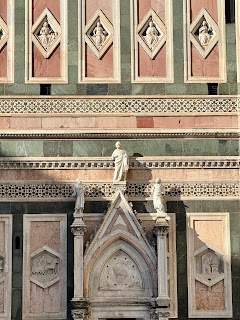












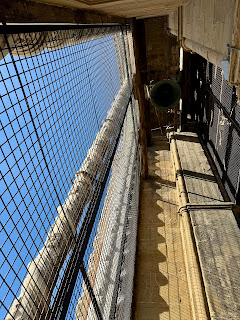




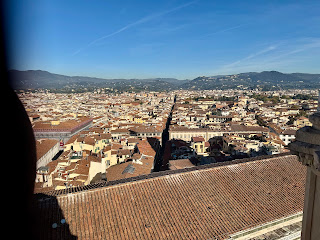
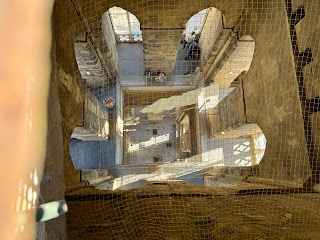

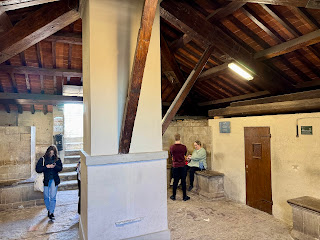











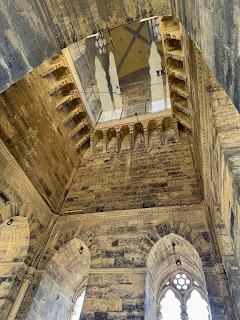





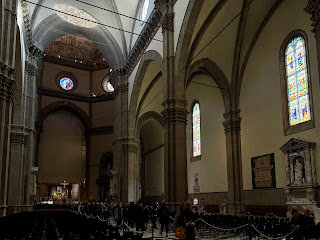






















































































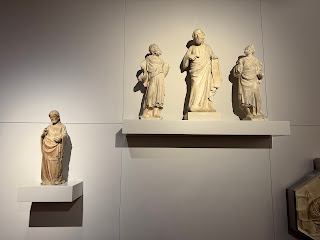


















No comments:
Post a Comment